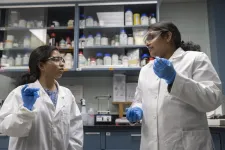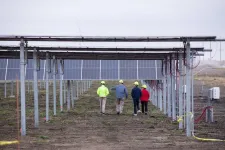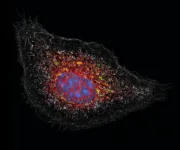(Press-News.org) COLUMBIA, Mo. — More than 2 billion people suffer from hidden hunger, a form of malnutrition where individuals lack essential micronutrients — like vitamins and minerals — even though they consume what appears to be an adequate amount of calories.
University of Missouri researcher Kiruba Krishnaswamy is focused on tackling this global challenge. She recently received a five-year, $532,000 Early Career Development (CAREER) award from the National Science Foundation (NSF) — the NSF’s most prestigious award for early-career faculty — in support of her project titled “FEAST (food ecosystems and circularity for sustainable transformation) framework to address hidden hunger.”
“Food is a universal basic human right,” said Krishnaswamy, an assistant professor with joint appointments in the MU College of Engineering and MU College of Agriculture, Food and Natural Resources. “Whenever we talk about hunger, we usually talk about chronic hunger, but hidden hunger is much more dangerous. If we don’t have enough micronutrients, our bodies won’t be able to absorb the required nutrients. This can create a snowball effect — leading to serious health issues like spina bifida, iron deficiency and anemia.”
Recognizing the urgent need for groundbreaking solutions, Krishnaswamy launched a project that incorporates engineering innovations in the creation of a culturally appropriate, circular food system model — a sustainable alternative to the existing linear food system.
“A linear food system is more focused on quantity or production, and sometimes during that process, food quality standards are not met,” Krishnaswamy said. “This can lead to people consuming empty calories. But, by making the system more circular, we’re tailoring solutions to the specific needs of individual communities, and then everyone can get the benefit of nutritious food in larger quantities.”
By addressing the specific needs of different under-resourced communities, Krishnaswamy aims to address the root cause of hidden hunger — and through that effort fight the related problem of chronic hunger.
Building a sustainable model
As part of the project, Krishnaswamy is partnering with the Osage Nation in Pawhuska, Oklahoma, to address hidden hunger and support food sovereignty — community-based, self-sustainable food practices — within the community. This process emphasizes the importance of preserving traditional agriculture practices while being ecologically sustainable.
Krishnaswamy has three main research goals for this part of the project. They are:
Understanding interactions: Investigating specific interactions in the soil-water-plant-food-people chain to pinpoint micronutrient deficiencies and inform targeted interventions.
Sustainable food processing: Exploring sustainable food process engineering strategies to enhance the nutrition, accessibility and availability of traditional Osage foods, such as elderberry.
FEAST framework development: Co-creating a FEAST framework integrating circular food systems and sustainable development goals to bolster food and nutrition security in the Osage Nation and beyond.
“Undernourishment and obesity are what we call the double burden of malnutrition because people are eating food, but they aren’t getting the right amount of nutrition,” Krishnaswamy said. “Recent studies have found micronutrients are a common connector between these two problems.”
It’s important to Krishnaswamy, whose grandfather was a farmer in India, to ensure that whatever process she designs respects and fits the culture it’s intended for.
“We could develop something in the lab, but if it’s not culturally appropriate or socially acceptable, then it’s not going to reach people,” Krishnaswamy said. “As a researcher, I learn a lot from the community members I meet, and it’s eye-opening to hear their stories. By listening to what they need, we can develop solutions based on what their specific needs and wants are.”
The project is committed to fostering educational outreach and community engagement by seeking to increase awareness about hidden hunger, sustainable food processing and sustainable development goals.
“I am grateful for this opportunity,” Krishnaswamy said. “Mizzou is a comprehensive place with researchers from all disciplines — from agriculture to engineering and medicine — where you can reach out to someone for help, and they get back to you or direct you to someone else who can assist.”
Krishnaswamy said she’s humbled to receive the NSF award and credits her support system, her family, students, colleagues and mentors — including the MU CAREER Club and community partners at the Osage Nation — for inspiring her to tackle difficult topics and help drive her goals for the field forward.
END
Taking on the global challenge of hidden hunger
Mizzou researcher Kiruba Krishnaswamy recently received an NSF CAREER award to develop a sustainable food system
2024-04-10
ELSE PRESS RELEASES FROM THIS DATE:
Engineers making a better, more profitable grid for distributing solar power
2024-04-10
AMES, Iowa – If you’re the Midcontinent Independent System Operator – the organization that manages the flow of high-voltage electricity across a central stripe of the U.S. and Canada, from Manitoba, Michigan and Minnesota through Iowa and all the way to Louisiana – you want energy supplies to meet the energy demands of 45 million people.
“We make sure the right amount of electricity is generated and transmitted to our member utilities,” says the regional grid operator’s website.
Balancing power supply and demand is complicated these days. Electricity is no longer exclusively generated by power plants using coal- or natural ...
Initiative increases awareness of the threats posed by light pollution to the global ocean
2024-04-10
Scientists, policy makers, and marine and environmental professionals across the world are being encouraged to sign up to a new initiative highlighting some of the global threats posed by light pollution.
The Global Ocean Artificial Light at Night Network (GOALANN) has been launched today at the United Nations Ocean Decade Conference in Barcelona.
It has been established by ecologists, oceanographers and social scientists who have spent more than a decade studying the impact of light pollution on the ocean, and the many species living in or near it.
The GOALANN network aims to expand on the impact of that work, unifying research groups ...
How the body switches out of “fight” mode
2024-04-10
Joint press release of Charité and Uniklinikum Erlangen
Cortisone and other related glucocorticoids are extremely effective at curbing excessive immune reactions. But previously, astonishingly little was known about how they exactly do that. A team of researchers from Charité – Universitätsmedizin Berlin, Uniklinikum Erlangen and Ulm University have now explored the molecular mechanism of action in greater detail. As the researchers report in the journal Nature,* glucocorticoids reprogram ...
Physicists discover a novel quantum state in an elemental solid
2024-04-10
Physicists have observed a novel quantum effect termed “hybrid topology” in a crystalline material. This finding opens up a new range of possibilities for the development of efficient materials and technologies for next-generation quantum science and engineering.
The finding, published in the April 10th issue of Nature, came when Princeton scientists discovered that an elemental solid crystal made of arsenic (As) atoms hosts a never-before-observed form of topological quantum behavior. They were able to explore and image this ...
Researchers show chemical found naturally in cannabis may reduce anxiety-inducing effects of THC
2024-04-10
FOR IMMEDIATE RELEASE
A Johns Hopkins Medicine-led research team has added to evidence that a chemical found naturally in cannabis (also known as marijuana) can — in the right amounts — lessen the anxiety-inducing effects of tetrahydrocannabinol (THC), the primary psychoactive sister chemical found in cannabis. The finding has the potential to advance the medicinal use of THC, and reduce the risks of its recreational use in some people.
The substance, called d-limonene, is one of the most abundant terpenes, or essential oils, in the cannabis plant, and has shown promise in rodent studies in reducing anxiety behaviors. However, there has ...
AI-powered ‘sonar’ on smartglasses tracks gaze, facial expressions
2024-04-10
ITHACA, N.Y. – Cornell University researchers have developed two technologies that track a person’s gaze and facial expressions through sonar-like sensing. The technology is small enough to fit on commercial smartglasses or virtual reality or augmented reality headsets, yet consumes significantly less power than similar tools using cameras.
Both use speakers and microphones mounted on an eyeglass frame to bounce inaudible soundwaves off the face and pick up reflected signals caused by face and eye movements. ...
Newly found genetic variant defends against Alzheimer’s disease
2024-04-10
NEW YORK, NY (April 10, 2024)--Columbia researchers have discovered a genetic variant that reduces the odds of developing Alzheimer’s disease by up to 70% and may be protecting thousands of people in the United States from the disease.
The discovery of the protective variant, which appears to allow toxic forms of amyloid out of the brain and through the blood-brain barrier, supports emerging evidence that the brain’s blood vessels play a large role in Alzheimer's disease and could herald a new direction in therapeutic development.
“Alzheimer’s disease may get started with amyloid deposits in the brain, but ...
Serious flu damage prevented by compound that blocks unnecessary cell death
2024-04-10
As lung cells are killed by the influenza virus, they burst open, releasing molecular signals that trigger the immune cells that can combat the infection. This strategy can be an important red flag that something is wrong; however, if one cell death response, called necroptosis, continues unchecked, it can cause life-threatening injury to lung tissue. In a study published April 10 in the journal Nature, Tufts University School of Medicine scientists and collaborators present a newly developed compound ...
CHOP, Stanford researchers identify protein that controls CAR T cell longevity
2024-04-10
Philadelphia, April 10, 2024 – CAR T cell therapy has revolutionized the way certain types of cancer are treated, and the longer those CAR T cells live in a patient’s body, the more effectively they respond to cancer. Now, in a new study, researchers at Children’s Hospital of Philadelphia (CHOP) and Stanford Medicine have found that a protein called FOXO1 improves the survival and function of CAR T cells, which may lead to more effective CAR T cell therapies and could potentially expand its use in difficult-to-treat cancers. The findings were published online today by the journal Nature.
T ...
Race, ethnicity, and delayed time to COVID-19 testing among health care workers
2024-04-10
About The Study: In this cross-sectional study of health care personnel (HCP), compared with non-Hispanic white HCP and clinical HCP with graduate degrees, non-Hispanic Black HCP, non-Hispanic HCP of other races, and HCP of all other professional and education backgrounds were more likely to have delayed COVID-19 testing. These findings suggest that time to testing may serve as a valuable metric in evaluating sociodemographic disparities in the response to COVID-19 and future health mitigation strategies.
Authors: DaMarcus ...
LAST 30 PRESS RELEASES:
Cuffless blood pressure technologies in wearable devices show promise to transform care
AI-based tool predicts future cardiovascular events in patients with angina
Researchers map how the cerebellum builds its connections with the rest of the brain during early development
Routine scans could detect early prostate radiotherapy changes
Fairness in AI: Study shows central role of human decision-making
Pandemic ‘beneath the surface’ has been quietly wiping out sea urchins around the world
Tea linked to stronger bones in older women, while coffee may pose risks
School feeding programs lead to modest but meaningful results
Researchers develop AI Tool to identify undiagnosed Alzheimer's cases while reducing disparities
Seaweed based carbon catalyst offers metal free solution for removing antibiotics from water
Simple organic additive supercharges UV treatment of “forever chemical” PFOA
£13m NHS bill for ‘mismanagement’ of menstrual bleeds
The Lancet Psychiatry: Slow tapering plus therapy most effective strategy for stopping antidepressants, finds major meta-analysis
Body image issues in adolescence linked to depression in adulthood
Child sexual exploitation and abuse online surges amid rapid tech change; new tool for preventing abuse unveiled for path forward
Dragon-slaying saints performed green-fingered medieval miracles, new study reveals
New research identifies shared genetic factors between addiction and educational attainment
Epilepsy can lead to earlier deaths in people with intellectual disabilities, study shows
Global study suggests the underlying problems of ECT patients are often ignored
Mapping ‘dark’ regions of the genome illuminates how cells respond to their environment
ECOG-ACRIN and Caris Life Sciences unveil first findings from a multi-year collaboration to advance AI-powered multimodal tools for breast cancer recurrence risk stratification
Satellite data helps UNM researchers map massive rupture of 2025 Myanmar earthquake
Twisting Spins: Florida State University researchers explore chemical boundaries to create new magnetic material
Mayo Clinic researchers find new hope for toughest myeloma through off-the-shelf immunotherapy
Cell-free DNA Could Detect Adverse Events from Immunotherapy
American College of Cardiology announces Fuster Prevention Forum
AAN issues new guideline for the management of functional seizures
Could GLP-1 drugs affect risk of epilepsy for people with diabetes?
New circoviruses discovered in pilot whales and orcas from the North Atlantic
Study finds increase in risk of binge drinking among 12th graders who use 2 or more cannabis products
[Press-News.org] Taking on the global challenge of hidden hungerMizzou researcher Kiruba Krishnaswamy recently received an NSF CAREER award to develop a sustainable food system








